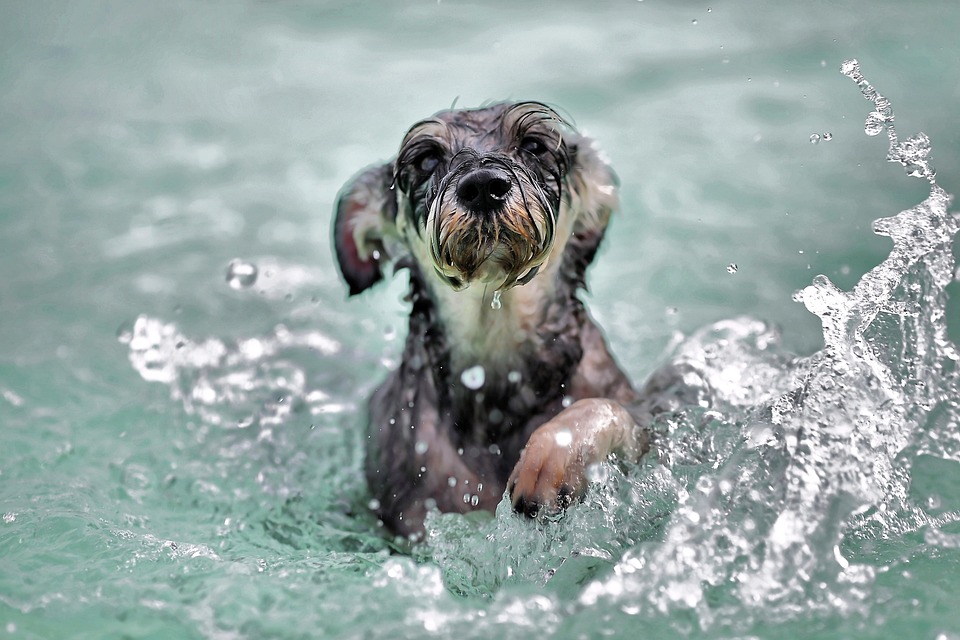Image credit goes to Pixabay
It makes sense that many pet owners are curious in how to teach a dog to swim. For your dog, swimming can be an incredibly enjoyable pastime.
Not only does swimming burn calories but it also offers a fun game of fetch in the water, where your pet can earn goodies as they get the hang of it.
Moreover, it’s low impact, hence suitable for canine arthritis and those dogs with joint pains.
You may be surprised, though, to learn that not all dogs are natural-born swimmers. Some breeds simply take to the water with ease, while others are not comfortable and even scared.
These pointers can assist in teaching your dog to swim, regardless of whether they are excited to be wet or not.
Know Your Dog
While they don’t always, breeds like retrievers, setters, and spaniels typically like swimming. In the past, these dogs were developed to be able to cross water, frequently in order to retrieve game for hunters.
Always keep dogs under supervision when near lakes, pools, ponds, and the ocean, such as Bulldogs and Puggs. Their wide chests, short legs, and short snouts make it hard for them to keep afloat. They have difficulty breathing, are weak swimmers by nature, and are easily drowned.
If your dog exhibits signs of dread, do not force them into the water, even if you believe they should enjoy it.
How to Teach a Dog to Swim Gradually by Introducing Your Dog to Water
Regardless of your dog’s age or skill level, they must be introduced to water.
Teaching a Puppy to Swim
To train your dog to swim, fill a kiddie pool with enough water to cover the pet’s front leg’s first joint. Smaller puppies will particularly benefit from this enclosed area.
Give them a toy or go in yourself to encourage them. You can progress to a bigger body of water when your puppy gets used to it.
If your pet experiences swimming during the first three months of their existence, you may also have a better chance of fostering a lifetime love of the water.
This period of socialization is one in which a puppy is in a phase of critical learning about the world around him.
Swimming Lesson for a Dog
With older and larger dogs than the puppies, you do not have to necessarily start in a kiddie pool. You can use a lake, a pond, or even the shallow end of a swimming pool.
Your pet could be interested in, or not be interested in, the water. Every time they reach the edge, provide them with a treat.
Now, place their favorite toy right next to them in the water. If they take it, then reward them again. Do this a few more times, each time moving the toy just an inch further away. Just be certain that your dog is having fun by keeping everything positive.
Support them under the belly and hind end, ease into the water a bit more when they are down to their belly and seem comfortable. They will be a little clumsy for a second, but they should paddle around on their own.
Now, have them swim to you in water that would be over their head when they can paddle well.
Keep in mind that teaching your dog to swim could take several attempts over the course of a couple of days. Also, stop the lesson and try again another time if they are ever very nervous.
Wear a Life Jacket
A life jacket will allow your dog to be confident in the water while keeping him safe. Children wear floaties on them while playing in the pool as they begin to learn how to swim. Some breeds are terrible swimmers and may be required to wear life vests their entire lives. Keep in mind, even great swimmers should always have a life jacket available if they’re going to spend any amount of time on a boat.
Gradually introduce your pet to the life jacket by showing it to him while giving rewards. Let him walk underneath when they appear comfortable. This will make them feel as if they are putting it on themselves.
Give them a treat and click the buckles shut if they stand still and the vest is lying on their back. Have them wear the life jacket for short amounts of time until they are comfortable in it before you get in the water.
Follow the Leader
Take along other dogs that your family or friends have that are familiar with the water during the swimming lesson. They will learn by example.
Also Read : Why Do Dogs Tilt Their Heads?
Be Selective About Water Toys
Selecting your toys wisely will help you make the most out of your time spent in the water when playing fetch. Choose a floating object; these are simpler to recover.
Consider size as well. Large or unwieldy toys could interfere with your pet’s swimming exercise if they have to work hard to get them.
Things to Avoid
Pet parents who are unsure about how to train their dog to swim safely should bear the following in mind:
- You should never just toss your dog into the pool; it’s not a fun game for either of them.
- Keep your pet away from the swimming water. Chlorine and saltwater can cause a serious electrolyte misbalance and stomach problems.
- Always keep your dog in your line of vision. The best swimmers should also stay next to you.
- Watch out for fast swells or undertows of the ocean and beware of powerful currents.
Fun Times!
Give your dog all of the love, toys, and attention while he is learning to swim. If he is having fun during the encounter, he will be more likely to come back for more.

